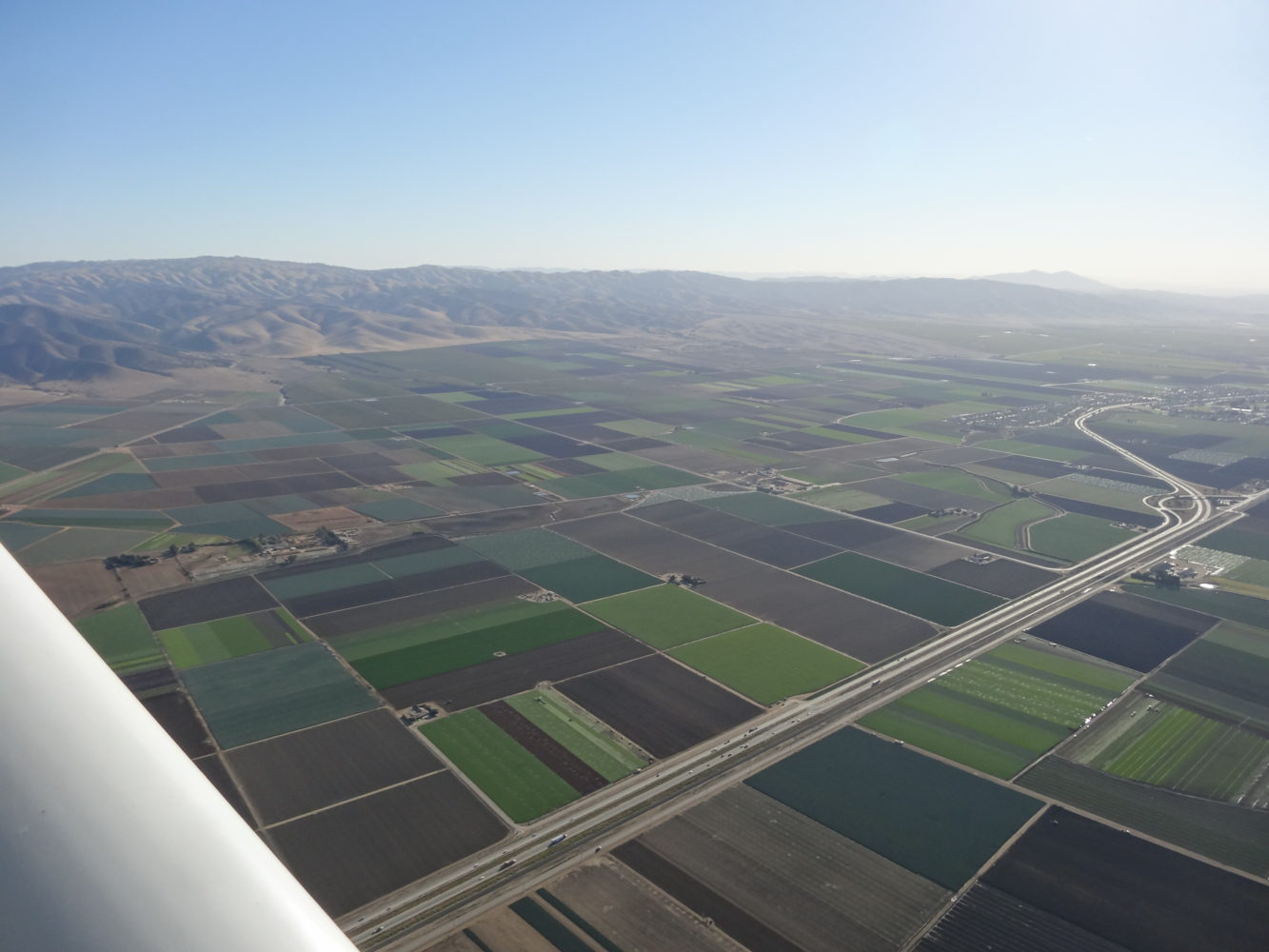
California agriculture puts food on our tables, wine in our glasses, money in our wallets — and a toxic brew into our groundwater, rivers and ocean.
Farming is deeply rooted in the American economy and culture. Thomas Jefferson ardently believed that farmers are “The most valuable citizens,” and proclaimed, “Those who labour in the earth are the chosen people of God.” Benjamin Franklin, another supporter of agrarian society, once said that agriculture is the only honest way…” for a nation to acquire wealth.
The U.S. agricultural lobby has influenced politics and policy since the 1870s, when 70 to 80 percent of the population was directly employed in farming. Today, less than three percent of the population farms, but agriculture is a bright spot in a struggling economy. Nearly half of American land is agricultural, and our farms are extremely productive – farmers produce 262 percent more food than in 1950. According to the U.S. Department of Agriculture, net farm income has reached an historic high, increasing from $85 billion in 2008 to more than $114 billion in 2012. Exports are also greater than ever. Given these numbers and our political and economic heritage, it is no wonder that American agriculture is deeply funded, well represented legally and politically potent.
But all is not well. In May, National Geographic magazine warned that agriculture is a “Mixed blessing,” and, ”If we don’t watch out, agriculture could destroy our planet.” The article chronicled global overuse of nitrogen fertilizers. America’s ”breadbasket” in the Midwest has created a dead zone in the Gulf of Mexico. The same thing is happening in America’s ”salad bowl” on California’s Central Coast where endangered sea otters are being killed: excess nutrients cause toxic algae to bloom in both fresh and salt water.
On that Central Coast, amid a gaggle of agriculture industry lawyers and lobbyists, Monterey Coastkeeper, Santa Barbara Channelkeeper and San Luis Obispo Coastkeeper are fighting to protect against rampant polluting practices.
For decades, the agriculture industry’s lobbyists here have worked overtime to avoid water quality regulation. Although agricultural pollution often flows from pipes (called tile drains) and ditches, agricultural operations are specifically excluded from point source discharge regulations under the Clean Water Act (33 USC § 1362(14)). Part of the Act’s treatment of the term point source states: “Does not include agricultural stormwater discharges and return flows from irrigated agriculture.” California’s 1969 Porter-Cologne Water Quality Control Act does require all dischargers, including farmers, to obtain permits, but these laws have been largely unenforced against the agriculture industry. In 2004, California’s Central Coast Regional Water Quality Control Board took the first small steps toward reducing agricultural pollution by passing new rules called the “conditional ag order” (short for Conditional Waiver of Waste Discharge Requirements for Discharges from Irrigated Agriculture). The conditional ag order is a permit tool that allows many similar dischargers to come under a single order, as long as each individual discharger complies with certain “conditions.” The Central Coast Water Board had started down a potholed road, inevitably colliding with agricultural interests.
The Central Coast, although not as extensive as California’s Central Valley, claims to be the most productive and profitable agricultural land in the state, and, some say, the world. The lower Salinas Valley alone – a sliver three miles wide and 40 miles long – produces 60 percent of the lettuce and 40 percent of the strawberries grown in the U.S. The smaller Pajaro and Santa Maria Valleys are equally productive. Over 100 varieties of vegetables and berries are grown on the Central Coast. McDonalds supplies its lettuce for Big Macs and Wal-Mart stocks its vegetable aisles from the bounty of the region.
This cornucopia has been filled at a high cost. Water quality on the Central Coast is likely the worst in California and among the foulest in the nation. While residents and tourists fawn over the green links at Pebble Beach, the rugged Big Sur Coast and the laid back fashion of Santa Barbara, inland residents and farm worker suffer. Fifty-five percent of the region’s inland waters are toxic, including 22 percent categorized as highly toxic. And conditions are getting worse.
“We have seen a 30- to-100-fold increase in domoic acid [an algal toxin] in water samples in the last decade or so,” reports Clarissa Anderson, a biological oceanographer at the University of California at Santa Cruz. “We think that the toxicity of these blooms is related to agricultural runoff.”
Among many sources of toxic pollution, testing has found toxic levels of chlorpyrifos and diazinon in the vast majority of samples. Both chemicals are only registered for agricultural use.
Extremely high levels of agricultural nitrates (farm fertilizers), which can cause cancer and be fatal to infants, have been found in rural drinking-water supplies. When residents of the small farming community of San Jerardo, outside Salinas, complained of sickness, hair-loss, stomach problems, sores and rashes, their drinking water was tested and found to have ten times the standard level for nitrates. Their symptoms disappeared when an alternative water source was provided. Nitrate pollution is so pervasive in these agricultural areas that many communities must abandon shallow wells or drill deeper ones to avoid polluted aquifers. A 2012 report to the California legislature found that in California’s Tulare Lake Basin and Salinas Valley, “Roughly 254,000 people are currently at risk for nitrate contamination of their drinking water,” and “Over 1.3 million people are financially susceptible because nitrate in raw source water exceeds the MCL [maximum contaminant level].”
In 2008 Monterey Coastkeeper, San Luis Obispo Coastkeeper, Santa Barbara Channelkeeper and Environmental Defense Center began advocating for a strong, enforceable “conditional ag waiver“ that discloses all data on agricultural discharges to the public and to water boards – in opposition to growers, who wanted a peer-enforced system that would have reported only aggregated data. After 18 months of delays, in February 2010 the Regional Water Board staff released a bold draft proposing regulation of toxic and nutrient discharges to both surface and ground waters, enforcement of riparian buffers between agricultural activities and streams, and regulation of sediment-discharges during storms. Some Regional Water Board members and agriculture advocates proclaimed the draft to be the most aggressive regulation of agricultural pollution in the United States. The prospect of such forceful regulation was greeted as appropriate and necessary by water-quality advocates, conservation organizations and environmental-justice groups, but agriculture portrayed the draft as overly zealous government intrusion and over regulation. From across the state, agricultural money and industry lawyers flooded into the Central Coast.
Most regional and state politicians have aligned themselves with the powerful agricultural interests, and industry trade groups have vigorously sought their assistance. When Western Growers Association sponsored legislation to abolish the Central Coast Regional Water Board, Monterey Coastkeeper and the California Coastkeeper Alliance, the voice for 12 Waterkeeper organizations, appeared before the all-powerful California Senate Environmental Quality Committee and killed the legislation. But one of the most powerful agricultural trade associations in the nation got its way when two Regional Water Board members were not re-appointed by the Governor – and Board membership fell below a quorum.
Over the next year, the Regional Water Board held hearings, with hundreds of people giving testimony. The agriculture industry advocated for weaker regulations and against individual monitoring and reporting, and the Board, without a quorum to approve anything, revised the conditional ag order five times, each time further weakening its staff proposal. One Board member revealed that the Board had been directed by the Governor’s office to “listen” to agriculture.
The previous and ineffective 2004 order was extended four times to accommodate further “listening” while the Board, without a quorum, discussed the new draft; after the first extension, each Regional Board extension was appealed by the three Central Coast Waterkeepers and allies to the State Board. The first appeal was summarily denied by the state and was immediately crafted into a lawsuit by the three Waterkeepers. The State Board has yet to take action on the other two appeals.
The three Central Coast Waterkeepers formed a coalition including the Environmental Justice Coalition for Water, San Jerardo Community and Clean Water Action. Hundreds of farm workers signed petitions supporting effective regulation, and many of them took valuable time off to offer testimony at hearings.
After nearly three years, in March of 2012, Governor Brown reappointed the two contested Board members, but the Board nonetheless adopted a severely weakened order. Even so, agriculture appealed the decision to the State Water Board, arguing for weaker regulation and a complete revocation of the order. The Waterkeepers also appealed, seeking to make the regulation stronger. They were abetted by Sierra Club California, Planning and Conservation League, Clean Water Action, Environmental Working Group, California Rural Legal Assistance, San Jerardo Cooperative, Environmental Justice Coalition for Water, and Ocean Conservancy, all of whom testified in their support. After a partial stay was granted in September 2012, the Waterkeepers sued the State Board, contending that the State had stayed provisions that demonstrate the efficacy of the order, which is required by law. That lawsuit has yet to come before the court.
The give and take that occurred over the next year was baffling. After the State issued draft revisions in June 2013 that further weakened the Central Coast Conditional Ag Order, the Waterkeepers and allies showed up through the summer at workshops and hearings on the draft revisions, pushing hard for a stronger draft. Then, on the eve of a September 10th adoption hearing, the State released a new draft that completely reversed all progress by allowing growers to entirely avoid meeting water-quality standards or complying with the schedule in the order. The State Water Board appeared to be “listening” to agriculture. On September 24th it approved a weakened and deeply flawed conditional ag order. Agriculture had trumped the champions of public health and the environment yet again. Deeply disappointed Waterkeepers, their allies and the Stanford University Environmental Law Clinic were left to evaluate their options and consider their next steps.
There is, at least, a glimmer of light emanating from the industry. Farmers have begun organizing to clean up their effluent in anticipation of more restrictive ag orders to come. And this year the California Department of Food and Agriculture announced its support of research to guide growers on curbing pollution.
But the three Central Coast Waterkeepers continue to fight a stinging, bruising, politically scarring battle for the earth, water and people of the region. Immediate and substantial remedies, not gradual change, are needed.
More from: Steve Shimek, Monterey Coastkeeper; Kira Redmond, Santa Barbara Channelkeeper; and Gordon Hensley, San Luis Obispo Coastkeeper

Communications Consultant Lola Dvorak supports CCKA’s strategic communications by helping waterkeepers tell their stories.



